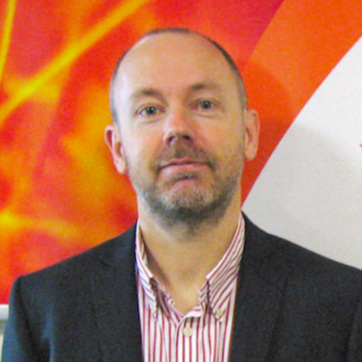IMI Europe Inkjet Ink Development Conference
10-11 April 2019
Crowne Plaza Hotel, Hamburg, Germany
Conference Programme
The IMI Europe Inkjet Ink Development Conference is aimed at inkjet development chemists looking to find out the latest products, technology and techniques, and exchange ideas with peers. The conference covers materials, characterisation, formulation, printing, curing and other aspects of digital printing solutions.
TECHNICAL ADVISORY BOARD
The conference is guided by a Technical Advisory Board consisting of key industry and academic figures, including:
Dr Simon Daplyn, Marketing Manager, Sensient Imaging Technologies
Dr Thomas Willers, Head of Applications & Science, KRÜSS
Frank de Jonge, Sales Director, Adphos
The Technical Advisory Board is chaired by Dr Tim Phillips of IMI Europe.
presenting companies
Fujifilm | Sensient | Ricoh UK Products | Evonik Coating Additives | BASF | KRÜSS | Adphos | Meteor Inkjet | ImageXpert | Trijet | Océ/University of Eindhoven | TTP Ventus | IGM Resins | Osaka Organic Chemicals | Heinrich Heine Universität Düsseldorf | Malvern Panalytical | DoDxAct
Additional Benefits
Networking
Meet with suppliers, industry experts and developers from other companies at our complimentary networking breaks, lunches and evening drinks reception. Excellent refreshments will help you enjoy this key part of the conference.
Sponsor Exhibits & Forum
Event sponsors will have their products and technology on display in the breakout area. In addition the Sponsors' Forum enables you to hear short presentations from sponsors with their latest news. If you are interested in becoming an event sponsor, please visit our sponsorship page. Coating a
Conference Programme
Wednesday 10 april 2019
Using high performance colorant dispersions to create opportunities for aqueous inkjet applications
Dr Hamid Shirazi, Segment Marketing Manager, Fujifilm
High performance colorant dispersions are one of the key factors in developing inkjet applications and driving the growth in industrial and packaging inkjet markets. The performance requirements of colorant dispersions are multidimensional. They are not only limited to formulation stability, reliable jetting and printing, but also deliver the critical to quality (CTQ) parameters of the intended end use applications. A "Life of an Inkjet Drop" methodology has been used as a tool to outline the requirements and role of colorant dispersions throughout the value chain starting from a pigment dispersion concentrate to a final printed product. Examples of different market applications outline what some of those requirements are and how a high-performance dispersion technology can deliver them.
Inkjet printing for packaging: Technical analysis
Dr Mark Bale, Director, DoDxAct
Over the last 10+ years the printing of labels and corrugated sheets have been the point of access for inkjet OEMs looking to gain a foothold in the packaging sector. The management of print quality through the successful integration of ink, printhead and process, such as the right maintenance methodologies, is critical to success. Through a combination of print sample analysis and laboratory-scale print experiments we look at the challenges involved with implementing different ink types into packaging applications and how the evolution of the platform technologies of ink and head is enabling the next generation of hardware with flexible packaging firmly in its sights for Drupa 2020.
Opportunities and challenges for inkjet printing of food and pharmaceuticals
Dr Simon Daplyn, Marketing Manager, Sensient
From the introduction of date coding onto eggs to the digital images found on birthday cakes, printing onto food and pharmaceutical products has long been established. There are now thousands of food and pharmaceutical items printed every day. In today’s market, the demand for personalisation and traceability for items such as baked goods, pills and capsules is greater than ever before. However, there are many challenges in formulating digital inks for these applications and a number of risks to be considered from micro contamination, heavy metals, pathogens or adulteration. This talk will look at the market, ink development and manufacturing challenges and the application needs.
Inkjet printing for pharmaceutical applications
Olga Kiefer, Heinrich Heine Universität Düsseldorf
Innovative technologies capture the markets in all sectors. But why not “misuse” an established technology to fulfil innovative approaches in highly regulated markets?! In recent years, inkjet printing was discovered by the pharmaceutical science and industry not only as a labelling tool for anti-counterfeit medicines but also as a potential manufacturing technique for on-demand personalised medicines. In contrast to the printing industry, drug-loaded inks and appropriate substrates have to be manufactured to pharmaceutical quality, meaning no harmful or toxic components are allowed. This talk will discuss the changes, recent progress and key challenges of inkjet printing from the pharmaceutical point of view.
Panel discussion: Inkjet development - challenges and opportunities
Inks for packaging - regulatory issues
Inks for food and pharmaceutical applications
Topics arising
The panel will be chaired by Dr Simon Daplyn, Marketing Manager, Sensient and include industry experts from the conference Technical Advisory Board and conference presenters.
Waveform optimisation and latency
Paul Best, Director of Engineering, ImageXpert
Development of quality inkjet inks and waveforms requires state-of-the-art characterisation equipment and techniques. In order to optimise the ink, as well as jetting conditions and waveform, it is vital to understand how the ink actually behaves, both when ejected from the nozzles and after it hits the substrate. We overview measurement of ink, waveform and substrate performance, using real-world data and images from automatic sweeping and analysis tools. We cover automatic waveform sweeps, drop tracking and sustainability data, and discuss how this information can be used for optimisation. We also provide a survey of other key equipment for inkjet development, including dropwatcher, ink supply, print controller, mist extractor, tools for head autopsy and belt or linear stage for creating test prints.
First experimental study using a novel device for characterising drop formation, drop substrate interaction, and wave form optimisation
Dr Thomas Willers, Head of Applications & Science, KRÜSS
In an inkjet printing process it can be effective to characterise the substrate using optical contact angle measurements and then choose the ink in order to ensure defined wetting, giving a sharp image and good adhesion. In this case, we need to find the best printhead and optimised waveform to ensure reliable drop formation. We review the theoretical concepts of drop formation and present an experimental study on various inks and model fluids using the new KRÜSS drop visualisation instrument, which enables continuous observation of the formation and flight of ejected drops. The drive waveform can be modified and changes in drop formation are monitored instantaneously. By using model fluids with different viscosities and surface tensions we will illustrate the interplay of those two fluid parameters and the waveform.
Manipulating printhead waveforms: Tools and techniques
Matthew Pullen, Product Manager Drop Watching Solutions, Meteor Inkjet
The choice of printhead driving waveform can make the difference between dazzling success and dismal failure for any industrial inkjet system. The topic of waveforms can seem complex and baffling given the myriad of printhead types, all driven in unique ways, together with a seemingly infinite variety of fluids. What is a waveform and how is it created? Can waveforms be optimised for specific applications? This talk will provide answers to these questions and more, with emphasis on the special tools and techniques required to manipulate waveforms.
Rheology and other techniques, importance to inkjet ink and inkjet printhead design
Mats Larsson, Product Technical Specialist, Malvern Panalytical
Inkjet inks must exhibit desirable rheological behaviour across the diverse conditions experienced during printing. Inks must be stable at the low shear stresses encountered during storage while meeting exacting flow and transfer performance targets at the extreme shear rates generated during printing. Inks and inkjet nozzle design are affected by many different aspects like viscosity, viscoelasticity, surface tension and particle size/concentration/density. Different aspects will be discussed in terms of ease of printing and ink stability. Results of different types of viscosity measurements and their impact on inkjet behavior are presented. Different techniques that aid understanding inkjet printhead functionality and inkjet design are presented.
Panel discussion: Ink characterisation equipment
The panel will be chaired by Dr Tim Phillips, IMI Europe and include industry experts from the conference Technical Advisory Board and conference presenters.
Hear short presentations from the event sponsors.
Join us for wine, beer, canapés and good company!
thursday 11 april 2019
Understanding complex rheology of inkjet inks and linking its dynamic properties to jetting performance
Dr Tri Tuladhar, Principle Consultant, Trijet
Optimising bulk properties of inkjet inks to printhead specifications alone are no guide to achieving reliable jetting. Any minor changes in ink components or batch variations and process conditions can drastically change high frequency complex rheology and extensional rheology. We will discuss the influence of ink components on complex rheology and hence the jetting behaviour and present novel rheological tools capable of quantifying complex rheology of inkjet at conditions like those during printing. These techniques provide useful tools in ink formulations, differentiate between apparently identical inks which show different jetting behaviour and recommend optimum jetting temperature and print frequency.
Multiscale modelling of drop dynamics in the inkjet printing process
Prof Herman Wijshoff, Océ Technologies / Eindhoven University
To comply with the increasing and diverging requirements for today’s inkjet technology, a fundamental understanding of the underlying processes is very important. It is essential that decisions can be made based on theoretical, numerical or experimental models as firm basis for further product development. We develop the experimental techniques, numerical codes and theoretical frameworks in close collaboration with academic research groups. Some highlights of this research program will be presented e.g. the quantitative detection of misting down to 1 femtolitre drops with a laser-induced fluorescence technique, the evaporation-induced segregation process within a single sessile drop with confocal laser microscopy and the migration of drops on a thin liquid layer with digital holographic cameras, supported by numerical simulations and theoretical evaluations.
Pulsation-free air micropump for ink control
Dr James McCrone, Managing Director, TTP Ventus
Precise control of meniscus pressure is important to delivering a high level of reproducibility within and between printheads, thereby avoiding visual defects in the images they print. Present meniscus control systems are relatively large and complex however, limiting print system design flexibility and performance. TTP Ventus offers a solution to this problem through its range of gas micropumps. Pulsation-free flow means that dampers and accumulators are no longer required, while rapid response and precision enable unrivalled meniscus control. In addition, modular system architectures are made possible by the pump’s small size. This talk will describe present meniscus control systems, introduce our pumps, and provide examples of new meniscus control architectures that they enable.
New acylphosphinoxide photoinitiators for water-based formulations and inks
Dr Gianni Casaluce, Researcher, IGM Resins
With increasing awareness about the environmental impact of industrialisation, waterborne UV-curable coatings have gained considerable importance due to their many advantages such as being environmentally benign, fast drying, low VOC, viscosity-controlled and low odour. In this rapidly evolving segment, many photoinitiators (PI) needed for UV curing are not water soluble or compatible, stunting the growth of this attractive slice of business. IGM Resins has created a new line of water soluble/compatible acylphosphine oxide-based photoinitiators that are key enablers of progress in this growing segment of the UV curing industry and in particular in water-based inks. This IGM presentation will focus on new developments and PI solutions for waterborne UV curable systems with some preliminary evaluation results.
VMOX – The new vinyl monomer for UV inkjet applications
Giovanni D’Andola, Business Development Manager, BASF
BASF recently added a new product to its broad functional vinyl monomers portfolio: vinyl methyl oxazolidinone, called VMOX. Compared to standard reactive diluents, VMOX has significant technical benefits such as being liquid at room temperature with a very low viscosity of 4 mPa/s, a low odour and favourable toxicological profile. VMOX’s high reactivity and good adhesion properties on several plastic substrates creates opportunities for innovative formulations. The talk will review VMOX’s capabilities and early application results.
High purity acrylate monomers
Kenji Kikuta, Monomer Overseas Sales Section, Osaka Organic Chemical
Acrylate monomers are the most common reactive diluent for UV/EB inkjet technology. However, usually they contain many kinds of oligomeric impurities due to the fundamental instability of the acrylate moiety during the synthesis process. Those impurities induce higher viscosity of the material because they have a higher molecular weight than the monomer itself. Osaka Organic Chemical has a proprietary distillation facility to offer higher purity, lower viscosity acrylate monomers than other manufacturers. This presentation shows how high purity acrylate monomers are good for UV/EB inkjet systems with the intention to motivate new business ideas.
The impact of drying technology on image quality and substrate compatibility
Frank de Jonge, Sales Director, Adphos
Cost and compliance of the ink are key factors to consider when high performance inkjet print-systems are positioned to replace analogue printing presses. Whether in book-printing, transactional, textile or packaging, in comparison with UV and E-Beam cured inks, water-based inks have advantages in cost and compliance. Water-based inks achieve certification for food- and skin contact, both in primary food packaging and in hygienic products or apparel. But what to do with the water after the ink hits the substrates? Adphos specialises in the drying and curing of water- and solvent-based inks. We explain the principle of near-IR drying and compare it with hot air and mid-wave IR drying performance. We will share our experience at drying of water-based inks on different substrates like paper, metal or flexible film.
Substrate wetting additives for aqueous single-pass inkjet inks
Dr Vedran Durasevic, Head of Digital Inks, Evonik Coating Additives
Stabilised pigment dispersions and substrate wetting additives are the most important building blocks formulators use in design of ink systems. They will determine jetting behaviour of an ink and dictate sustainability of the process. Selection of wetting additives in industrial inkjet is governed by strict formulation principles that have to be followed to achieve optimum drop spread within given time. This talk will focus on associating general chemical composition of surfactants with their behaviour in low viscosity aqueous ink systems. Experimental data that demonstrates theoretical division of surfactants into ‘static-/dynamic- surface tension reduction’ and ‘super-wetter’ additives that do not support stabilisation of foam will be shown.
Media qualification for high speed inkjet
Dr Alice Zhang, Print Specialist, Ricoh UK Products
Media is one of the key factors in an inkjet system. It affects print outputs such as run-ability, dry time, image quality and post finishing results. There are different types of inkjet technologies in the current market that allow the user to print on various types of media, such as paper, plastics, cardboard, foil etc. Paper is the most common substrate used by high speed inkjet systems. So how is paper made? Why is paper important in an inkjet system? How can we choose the right paper to meet customer requirements? How do we handle paper during printing? This talk will focus on paper knowledge and print quality assessment in order to answer all these questions.

























